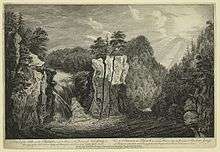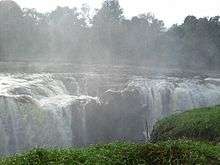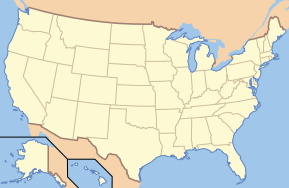Great Falls (Passaic River)
|
Paterson Great
Falls National Historical Park | |
|
The Great Falls of the Passaic River. | |
   Location of the Great Falls of the Passaic River in Passaic County. Inset: Location of Passaic County in New Jersey. | |
| Location | Paterson, New Jersey |
|---|---|
| Coordinates | 40°54′58.28″N 74°10′53.75″W / 40.9161889°N 74.1815972°WCoordinates: 40°54′58.28″N 74°10′53.75″W / 40.9161889°N 74.1815972°W |
| Website | Paterson Great Falls National Historical Park |
| NRHP Reference # | 86001507[1] |
| NJRHP # | 2364 |
| Significant dates | |
| Added to NRHP | August 14, 1986 |
| Designated NHLD | May 11, 1976[2] |
| Designated NHP | November 7, 2011 |
| Designated NJRHP | June 24, 1986 |
The Great Falls of the Passaic River is a prominent waterfall, 77 feet (23 m) high, on the Passaic River in the city of Paterson in Passaic County, New Jersey, United States. The falls and surrounding area are protected as part of the Paterson Great Falls National Historical Park, administered by the National Park Service. The Congress authorized its establishment in 2009.[3]
One of the United States' largest waterfalls, it played a significant role in the early industrial development of New Jersey starting in the earliest days of the nation. It is part of the Great Falls of Paterson-Garret Mountain National Natural Landmark.[4] It has also been designated as a National Historic Landmark District since 1976.[5][6] The Great Falls' raceway and power systems were designated an Historic Civil Engineering Landmark in 1977.[7]
History
Formation and early history
Geologically, the falls were formed at the end of the last ice age approximately 13,000 years ago. Formerly the Passaic had followed a shorter course through the Watchung Mountains near present-day Summit. As the glacier receded, the river's previous course was blocked by a newly formed moraine. A large lake, called Glacial Lake Passaic, formed behind the Watchungs. As the ice receded, the river found a new circuitous route around the north end of the Watchungs, carving the spectacular falls through the underlying basalt, which was formed approximately 200 million years ago.
The falls later became the site of a habitation for Lenape Native Americans, and later for Dutch settlers in the 1690s.
Industrial development

In 1778, Alexander Hamilton visited the falls and was impressed by its potential for industry. Later when Hamilton was the nation's Secretary of Treasury, he selected the site of the nation's first planned industrial city, which he called a "national manufactory." In 1791, Hamilton helped found the Society for the Establishment of Useful Manufactures (S.U.M.), state-chartered private corporation to fulfill this vision. The town of Paterson was founded by the society and named after New Jersey Governor William Paterson in appreciation of his efforts to promote the society.
Hamilton commissioned civil engineer Pierre Charles L'Enfant, responsible for the layout of the new capital at Washington, D.C., to design the system of canals known as raceways supplying the power for the watermills in the new town.[8] As a result, Paterson became the nucleus for a burgeoning mill industry. In 1793, two years after the society's foundation, the falls was the site of the first water-powered cotton spinning mill in New Jersey. In 1812, it was the site of the state's first continuous roll paper mill. Other products whose construction used the falls as a power source include the Rogers Locomotive Works (1832), the Colt revolver (1837), and the USS Holland (SS-1) (1898). The oldest extant structure in the historic district is the Phoenix Mill, built in 1813.[9] The industrial area also became the site of labor unrest, as it was a center for the 1913 Paterson silk strike. Immigrant workers, facing harsh conditions in factories staged numerous strikes, giving the United States its first organized labor movement.

The society continued operation until 1945 when its charter and property were sold to the city of Paterson. The area fell into disuse with the steep decline of industry in the region during the 20th century. In 1971, the Great Falls Preservation and Development Corporation was established to restore and redevelop the historic mill buildings and raceways.
Great Falls State Park
The State of New Jersey has announced plans for a new urban state park in Paterson surrounding the Great Falls, called Great Falls State Park.[10] The master plan for the park calls for utilizing surrounding industrial areas for parklands that include a trail network and recreation areas, and creating new areas to view the falls.
The falls in literature
The unique history of the falls and the city were described in the five-volume philosophical poem Paterson by William Carlos Williams. Among the episodes described in Williams' poem is the 1827 leap over the falls by Sam Patch, who later became the first known person to perform a stunt at Niagara Falls.
The falls in television
The falls were featured in the pilot as well as episode 6 of the first season of The Sopranos, Pax Soprana in which two mobsters threw a drug dealer off the bridge and into the falls, to his death.
Viewing the falls

The Falls are viewable from Haines Overlook Park on the south and Mary Ellen Kramer Park on the north. Drive-by viewing is available from McBride Avenue where it crosses the river just above the Falls. A footbridge over the Falls gorge (historically, the eighth such bridge to span this spectacular chasm) also serves as an exciting outlook point from which many have captured the famous Falls rainbow. A visitor's center at the corner of Spruce and McBride Avenues, in the heart of the Great Falls Historic District, provides a historical overview of the falls and the industrial and cultural history of Paterson.
National Natural Landmark

The Great Falls of Paterson - Garret Mountain is a National Natural Landmark designated in January 1967 and were expanded in April 1967 to include nearby Garret Mountain. Together they help demonstrate how jointed basaltic lava flow shaped the geology of the area during the Early Mesozoic period through both extrusion and intrusion.[11] The designation protects the site from federal development, but not from local and state development. Redevelopment of the decayed adjacent industrial areas has been an ongoing controversial topic. An attempt in the 1990s to redevelop the adjacent Allied Textile Printing Co. (ATP) facility, destroyed by fire in the 1980s, into prefabricated townhouses was initially approved by the city but later repelled by a coalition of local citizens seeking to preserve the historic character of the district.
National Historical Park
Paterson Great Falls National Historical Park was authorized to be added to the National Park System of the United States under the Omnibus Public Land Management Act.[3] On March 30, 2009, President Obama signed legislation authorizing the falls as a national historical park, which would provide additional federal protections for the 77-foot waterfall.[3][12][13] By 2011, Great Falls State Park and other land along the Passaic River were transferred to the federal government for the creation of the park. Formal establishment as a unit of the National Park System required action by the Secretary of the Interior,[3] which took place November 7, 2011, when Secretary Salazar formally accepted lands on behalf of the United States, and dedicated the park as the nation's 397th park system unit.[14]
Hydroelectric facility
The hydroelectric plant at the falls is operated by Eagle Creek Renewable Energy, which is considering commissioning another facility downstream at the Dundee Dam.[15][16]
See also
- List of waterfalls
- List of National Natural Landmarks
- Garret Mountain Reservation
- National Register of Historic Places listings in Passaic County, New Jersey
- Paterson Museum and Rogers Locomotive and Machine Works
- Old Great Falls Historic District
- Lambert Castle
References
- ↑ National Park Service (2007-01-23). "National Register Information System". National Register of Historic Places. National Park Service.
- ↑ "Great Falls of the Passaic Society for Useful Manufacturing HD". National Historic Landmark summary listing. National Park Service. 2008-06-23.
- 1 2 3 4 111th U.S. Congress. "Public Law 111-11 § 7001(b)(1)(B)" (PDF). Retrieved 2009-08-20.
- ↑ NPS NNL Summary for Great Falls and Garret Mountain
- ↑ http://news.yahoo.com/s/ap/20090326/ap_on_re_us/great_falls_state_park
- ↑ http://www.northjersey.com/news/national/obama_preview.html
- ↑ American Society of Civil Engineers. "Designated Historic Civil Engineering Landmarks". Retrieved 2009-08-20.
- ↑ Goldberger, Paul (August 3, 2009), "Facelift The Falls", The New York, p. 23, retrieved 2011-07-24
- ↑ http://www.patersonhistory.com/industry/phoenix.html
- ↑
- ↑ "Great Falls of Paterson-Garret Mountain". National Park Service. Retrieved 2009-01-01.
- ↑ http://www.nj.com/news/index.ssf/2009/03/great_falls_in_paterson_become.html
- ↑ Mroz, Jacqueline (March 27, 2009). "The Great Falls: Power for Another Revolution?". New York Times. Retrieved 2009-04-01.
- ↑ Adam Fetcher. "Salazar, City Officials Sign Agreement to Establish Paterson Great Falls National Historical Park". Retrieved 2011-11-07.
- ↑ O'Neill, James M. (September 5, 2014). "UnitedWater att Dundee Dam". The Record. Retrieved 2014-09-14.
- ↑ O'Neill, James M. (September 5, 2014). "Hydro operator at Paterson's Great Falls weighs putting new hydro project at Dundee Dam". The Record. Retrieved 2014-09-05.
External links
| Wikimedia Commons has media related to Great Falls (Passaic River). |
- Paterson Great Falls National Historical Park
- National Park Service: On Designation of the Area as part of the National Park System
- Paterson Friends of the Great Falls
- Passaic County, NJ Passaic County Board of Chosen Freeholders
- Hamilton Partnership for Paterson
- From Local Landmark to National Site
.jpg)
